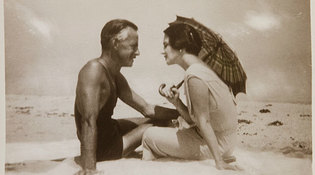 loading
loading
featuresMementos of a passionEugene O’Neill’s jewelry box—in the Beinecke Library collection—tells the story of his stormy relationship with his wife Carlotta. Claudette Joannis is an expert on historical and modern jewelry and the author of several books. This article was translated from the French by Jane Merrill.  Eugene O’Neill and Carlotta Monterey O’Neill, shown here on a beach in 1931, exchanged many pieces of jewelry as tokens of their love. After Eugene’s death, Carlotta gave his jewelry, and his archives, to Yale. View full imageA piece of jewelry, whether it belongs to a woman or a man, enters into an intimate connection with the person who owns and wears it. Jewelry reveals hidden sentiments; it reflects one’s interior being. Eugene O’Neill’s jewelry box, now in the archives of the Beinecke Library, commemorates a partnership. The pieces comment, poignantly and vividly, on the most important relationship of O’Neill’s adult life. The celebrated American playwright was born in 1883. In 1926 he met Carlotta Monterey (1888–1970), who became his third wife; theirs was the longest, stormiest, and most passionate of his marriages. It was Carlotta who would bequeath all her husband’s archives to Yale. She also left Yale many photographs and memorabilia, among which was the box of jewelry. The contents of this box retrace the famous couple’s life together. The objects, some precious, some quite modest, evoke a marriage, a career, and an era.
When Eugene met Carlotta, he was still married and already enjoyed an important reputation. She—very beautiful, and, thanks to a gift from a wealthy lover, very rich—was a stage actress, though more renowned for her looks than for her performances. She had been on the cover of Harper’s Bazaar and Vanity Fair a number of times. Eugene and Carlotta, both 38 when they met, found a connection at once. Eugene, depressed and alcoholic, haunted all his life by memories of an unhappy childhood, longed for comfort and stability; Carlotta was prepared to give them. The two formed an understanding that was not yet love but would become love. In order to be with Carlotta, Eugene abandoned his second wife, the writer Agnes Boulton, and their two children. The couple married in 1929, and from then on their bond was extraordinary. The actress Lillian Gish (1893–1993), a friend, was a witness to this intense relationship: “I have never seen a man and a woman so passionately in love. They did not seem to need anything outside of each other.” The first ten years were marked by periods of great creative effervescence—followed by great distress, as Eugene’s health gradually failed. After his death in 1953, Carlotta would recall: “It was a privilege to live with him because it was mentally stimulating. My god, how many women have husbands who are very stimulating?” But also, she said, “I worked like a dog. I was his secretary. I was his nurse. I built and ran his houses. He wrote the plays. I did everything else.” To ensure that her husband could write in the greatest possible comfort and solitude, she created a protective, carefully guarded space around him. They received only a few special friends in the many houses that she rented or had built in France and the United States. This style of life allowed Eugene the complete quiet he needed for his work. The jewelry and objects in the Beinecke collection derive from this early period of their relationship.
|
|